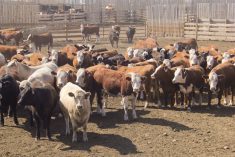Chicago | Reuters — Live cattle futures on the Chicago Mercantile Exchange rose on Tuesday with the benchmark June contract hitting a four-week top, led by a surge in feeder cattle futures and optimism about consumer demand for beef, traders said.
CME June live cattle settled up 1.7 cents at 138.475 cents/lb. while May feeder cattle jumped 4.325 cents to end at 169.4 cents/lb.
Feeder cattle got a boost as Chicago Board of Trade corn futures fell nearly three per cent, signaling cheaper feed costs, on signs of progress to resolve the conflict between Russia and Ukraine that has disrupted grain exports in the Black Sea.
Read Also

U.S. livestock: Feeder cattle hit contract highs on tight supply
Chicago | Reuters – All Chicago Mercantile Exchange feeder cattle futures and most live cattle futures hit contract highs on…
Crude oil prices eased and Wall Street equity markets rose after Russia pledged to cut down on military operations around Kyiv and in northern Ukraine, while Ukraine proposed adopting a neutral status.
Moves in those markets helped lift cattle futures.
“With energy (prices) down and the stock market up, the consumer maybe has more interest in buying high-priced beef,” said Don Roose, president of Iowa-based U.S. Commodities.
Also, beef prices typically start to climb in the spring with the approach of Memorial Day weekend, the traditional start of the summer grilling season, Roose added.
CME lean hog futures declined, with the June contract retreating from life-of-contract highs set a day earlier as traders braced for the U.S. Department of Agriculture’s quarterly Hogs and Pigs report due Wednesday.
CME June hogs settled down 1.425 cents at 124.625 cents/lb.
Analysts surveyed by Reuters on average expect USDA to show that the U.S. hog herd was 1.2 per cent smaller as of March 1 compared to a year earlier.
However, Roose noted, the average analyst estimate of the herd, at 73.046 million head, would still be the fourth-largest March 1 figure on record.
— Julie Ingwersen is a Reuters commodities correspondent in Chicago.
















